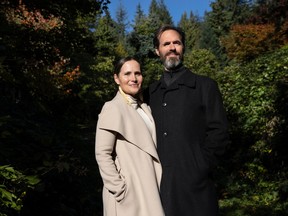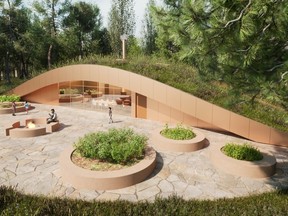The founders of Mindful Architecture will speak at this year's Zero Waste Conference, held Nov. 1 and Nov. 2 in Vancouver.

An architectural firm in North Vancouver wants to transform the way houses are built so they intertwine with nature and can withstand the challenges of climate change.
One of the firm’s designs, the “Earth Sheltered Solar Pit House,” that uses a concrete-like material that sequesters carbon, and a vegetated roof system that resist fire, which could replace wood-frame houses where wildfire has destroyed homes.
Article content
Article content
Architect T. Maginnis Cocivera and designer Geneviève Noël, who founded Mindful Architecture in 2017, will be speaking at Metro Vancouver’s annual Zero Waste Conference, which runs Nov. 1 to Nov. 2 in Vancouver.
Noël, who has mixed Indigenous and French heritage, has a passion for building with the landscape. Her designs, which include finding form through the path of the sun or the flow of water, aim to revitalize Indigenous culture.
Cocivera, an award-winning architect, has worked in many cities around the world, and contributed to projects with Busby Perkins + Will in Vancouver, notably Plan Abu Dhabi 2030 and the Centre for Interactive Research on Sustainability at UBC.
They said the pit house or their fire-resistant long house, could be a solution for the housing crisis. Although they are still working on cost estimates, Cocivera said using 3D printers and cement-like products have already been tried in other cities around the world to provide low-cost housing.

He added that the print media aggregate that they would be using, which includes renewable keratin to strengthen the product, can also sequester carbon.
By signing up you consent to receive the above newsletter from Postmedia Network Inc.
Thanks for signing up!
A welcome email is on its way. If you don't see it, please check your junk folder.
The next issue of Sunrise will soon be in your inbox.
Article content
Article content
“What these printers offer is first of all low cost. And secondly, they can do circular forms, which traditionally has been cost-prohibitive to build. But those circular forms are really what the vast majority of Indigenous housing is based on,” he said.
“There are many different examples of circular forms for Indigenous housing. They typically have fire in the middle and then living space arranged around the fire. And that’s a very different spatial arrangement than what you find in a colonial bungalow with a fireplace in the living room.”
The pit house has a modern green roof, and the area around the house would provide habitat and biodiversity, said Noël. They can be single units or large enough for multigenerational families.
“We also want to make sure that we’re harvesting water and creating the right conditions to grow food, as all of these issues are really going to come to the forefront over the next decades because of climate change,” said Noël, who is also studying ways to incorporate permaculture into design.
“Another way to look at it is that if we keep cutting the trees, we’re limiting our oxygen production, and it’s a very big problem in the long term. So looking at alternative materials for homebuilding is really desirable,” added Cocivera.
Article content
One of the team’s finished buildings, the McMurray Métis Cultural Centre, interweaves nature and Indigenous culture. For example, landscape designs restored Indigenous biodiversity and created foraging trails around the building, which also uses Earth tubes and geo-piles which pre-temper outside air for passive warming in winter and cooling in summer, and a biomass boiler provides carbon neutral heat through the long northern winter, fuelled by standing dead timber left behind by the Horse Creek Wildfire of 2016.
To learn more about the Zero Waste Conference, visit zwc.ca.
Related Stories
-

Vancouver architect makes the case for why 'view cones' matter
-

B.C. Climate News: Earth had hottest September on record | Deadly wind storms and floods batter northern Europe
-

B.C., Yukon among world's top regions for climate change driven heat this summer: study
Bookmark our website and support our journalism: Don’t miss the news you need to know — add VancouverSun.com and TheProvince.com to your bookmarks and sign up for our newsletters here.
You can also support our journalism by becoming a digital subscriber: For just $14 a month, you can get unlimited, ad-lite access to The Vancouver Sun, The Province, National Post and 13 other Canadian news sites. Support us by subscribing today: The Vancouver Sun | The Province.
Article content


